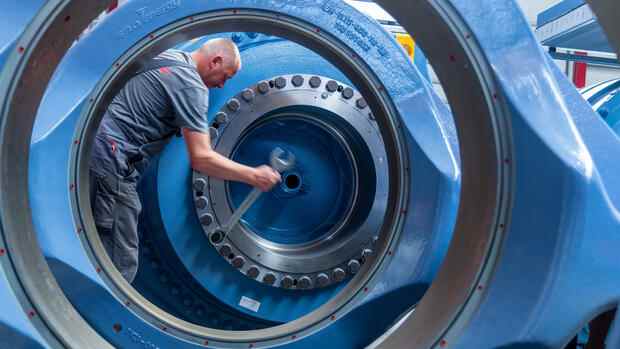In the manufacturing sector, Germany has the fourth highest labor costs in an EU comparison, behind Denmark, Belgium and Sweden.
(Photo: dpa)
Berlin According to a study by the Institute for Macroeconomics and Business Cycle Research (IMK), labor costs in the private sector in Germany rose by 1.2 percent last year and thus developed comparatively moderately.
“The price-wage spiral that some have invoked has not been an issue so far,” says Sebastian Dullien, the scientific director of the IMK, which belongs to the trade union-affiliated Hans Böckler Foundation. The authors of the study emphasize that wage developments do not pose a threat to Germany’s international competitiveness.
In the first Corona year 2020, the labor costs, which in addition to the gross wage also include the employer’s share of social security contributions, expenses for training and further education and certain taxes, increased by 2.2 percent. On average in the EU countries, labor costs rose by 1.5 percent last year, slightly more than in Germany. In the euro zone they increased by 1.0 percent.
According to data from the European statistics office Eurostat, Germany ranked seventh among the EU countries last year with labor costs of 37.30 euros per hour behind Denmark, Luxembourg, Sweden, Belgium, France and Austria, where amounts between 37.70 euros and 48 .30 euros were due.
Top jobs of the day
Find the best jobs now and
be notified by email.
In the manufacturing sector, which is particularly exposed to international competition, Germany ranked fourth in the EU comparison with labor costs of EUR 41.90 per hour – after third place in the previous year.
The IMK researchers write that labor costs in Germany have risen comparatively moderately, although many companies continued to use short-time work last year due to the ongoing corona pandemic and supply chain problems. This tends to increase labor costs because labor costs tend not to fall in proportion to the number of hours worked.
>> Read here: Easier access to short-time work benefits is to be extended
In any case, unit wage costs, which relate labor costs to productivity developments, are more meaningful than labor costs. They increased by 0.8 percent in 2021 – after 3.4 percent in the previous year. If you take both pandemic years together, unit labor costs rose by 2.1 percent on average over the year.
The researchers write that they would have corresponded almost exactly to the inflation target of the European Central Bank (ECB), which envisages a price increase of 2.0 percent. Despite the comparatively strong increase in 2020, unit labor costs have only increased by an annual average of 1.3 percent since the turn of the millennium – and thus slower than the average of the other members of the euro zone with 1.9 percent.
Cumulatively, the development of unit labor costs in Germany since 2000 has been 5.3 percentage points below the average for the euro area.
The study goes on to say that the enormous German current account surplus, which amounted to 238 billion euros or 6.7 percent of economic output in 2021, shows that there can be no question of a threat to competitiveness due to high unit labor costs.
>> Read the comment from the Handelsblatt chief economist: The world is being rearranged – and that is expensive
Since the economic environment has changed drastically as a result of the pandemic and the Ukraine war, it will be more important to strengthen domestic demand in the future. “A wage development that ensures that employees participate sufficiently in the progress of social prosperity even in these times of change is essential for this.”
IMK Director Dullien points out, however, that the currently high inflation rates cannot be offset with wage policy alone: ”This is where economic policy as a whole will be in demand.” and reduce the risk that price-wage spirals will still set in motion, according to Dullien.
More on this: Labor costs in Hamburg are the highest in Germany
